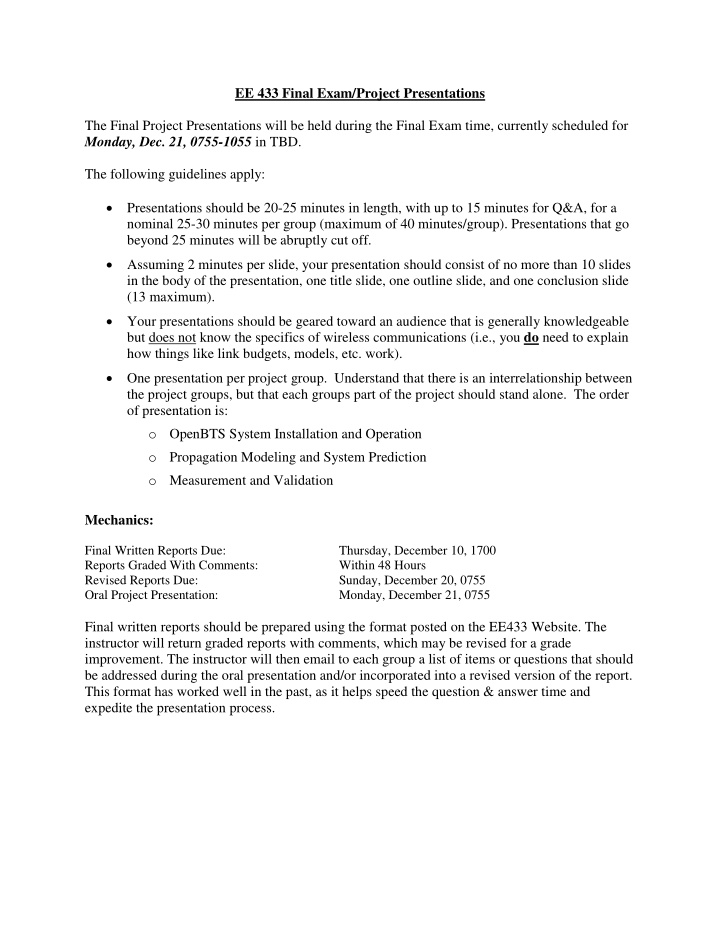



EE 433 Final Exam/Project Presentations The Final Project Presentations will be held during the Final Exam time, currently scheduled for Monday, Dec. 21, 0755-1055 in TBD. The following guidelines apply: Presentations should be 20-25 minutes in length, with up to 15 minutes for Q&A, for a nominal 25-30 minutes per group (maximum of 40 minutes/group). Presentations that go beyond 25 minutes will be abruptly cut off. Assuming 2 minutes per slide, your presentation should consist of no more than 10 slides in the body of the presentation, one title slide, one outline slide, and one conclusion slide (13 maximum). Your presentations should be geared toward an audience that is generally knowledgeable but does not know the specifics of wireless communications (i.e., you do need to explain how things like link budgets, models, etc. work). One presentation per project group. Understand that there is an interrelationship between the project groups, but that each groups part of the project should stand alone. The order of presentation is: o OpenBTS System Installation and Operation o Propagation Modeling and System Prediction o Measurement and Validation Mechanics: Final Written Reports Due: Thursday, December 10, 1700 Reports Graded With Comments: Within 48 Hours Revised Reports Due: Sunday, December 20, 0755 Oral Project Presentation: Monday, December 21, 0755 Final written reports should be prepared using the format posted on the EE433 Website. The instructor will return graded reports with comments, which may be revised for a grade improvement. The instructor will then email to each group a list of items or questions that should be addressed during the oral presentation and/or incorporated into a revised version of the report. This format has worked well in the past, as it helps speed the question & answer time and expedite the presentation process.
Just like the project report, each presentation should address the following three topics: Introduction & Problem Statement. Provide a brief overview/need/motivation of your project and address the need/motivation, goals, and objectives for the project. Background. Provide a brief overview of any necessary background material. Use this section to educate your audience on any specifics they will need to know to understand the technical details of your project component (e.g., introduce propagation, channel models, link budgets, etc.). Limit to a maximum of 1/3 of your presentation, or 3 slides. Methodology/Approach. Describe briefly how you went about addressing your problem. Analysis, simulation, design, and code examples should be presented in this section. Results . 1-2 Slides that summarize the major findings and results of your work. Compare predicted vs. measured data, predicted vs. actual performance, and share any results that demonstrate whether your project was successful. Discussion & Conclusion. Discuss what worked and what didn’t work. If something was unsuccessful, explain why it was unsuccessful and what (if anything) needs to be addressed/improved/corrected to make it successful. If you had success, explain how your success fits into the broader context of the problem you are addressing.
Team Members: ____________________________ Evaluator: _____________________ Score Item 0 3 5 Weight Score (0 – 5) Need, and objectives Clear & concise “forest Introduction Not given presented but x 1 = view” of project incomplete Mission and expected Problem Present but not Missing outcome clearly motivated x 1 = Overview motivated or vague. and articulated Incomplete description Wireless system operation of important material, Insufficient level of and associated models Background x 2 = including channel detail for design clearly articulated and tied models, link budgets, together. or system operations. Present but not Engineering Present, fully justified, Missing justified, quantified, or x 2 = Requirements and appropriately formed too abstract Some but not all of the Clearly described approach is described; approach to analyzing the Insufficient level of Methodology missing steps or problem space and x 2 = detail for design incomplete associated engineering information. process. Block diagrams & Some but not all Design Insufficient level of functional descriptions design decisions x 3 = Architecture detail for design clearly provided. Design sufficiently described. decisions justified. Clearly and concisely Barely substantiate Some discussion of discussed data, data, simulation, or data, simulation, or simulation, and predicted predicted results; no predictions; delineated Engineering results and tied all three discussion the origin of some x 4 = Analysis together. Clearly performance performance delineated the origin of differences between differences between performance differences; predicted and tested. predicted and tested. identified contributors. Team struggled with Response to Team is completely Answered questions some questions but x 1 = Questions thrown or defensive readily and professionally maintained composure Some slides are Slides are legible, correct, Slide Quality x 2 = Completely illegible difficult to read and visually appealing Low energy but Mumbling and/or no Presence understandable and Dynamic and charismatic x 1 = eye contact with eye contact Proper timing, but Presentation is polished, presentation contains Late, not prepared, professional, and clearly Professionalism x 1 = typos, seems rough, too long/short delivered, clear & concise inadequate figure/slide titles. titles. Presentation Sum: Score:
Recommend
More recommend